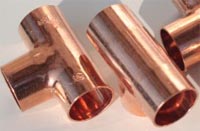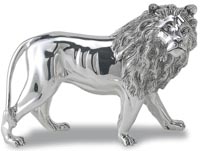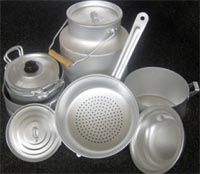
Heated copper subject with the black (burned) surface put in a solution of alcohol. Alcohol reacts with copper oxide, restor it to pure metal, forming a new class of chemical compounds - aldehydes. Now your "copper coin" shines again.

If you have a solution, formed after cleaning of copper from its oxide (solution of aldehyde), use it to clean silver, put silver in this solution. Reaction of silver mirror is name of this reaction.
Cleaning silver : another way (depending on the degree of oxidation): Heavily oxidized silver put in the technical solution of ammonia (10 % ammonia solution) for about 1 hour. Instead of ammonia, you can use a solution of baking soda (two teaspoons of baking soda per 100 ml of water - but it's way longer). If the solution (baking soda) heat to boiling, then the process can significantly speed up.
Cleaning silver: another way:
Silver product boiled in soda solution and in aluminum cookware or any other, but with the addition of pieces of aluminum wire, foil. In the alkaline solution, formed by the hydrolysis of soda, aluminum restores silver to metal:
3Ag2S+2Al+5NaOH+3H2O=6Ag+2Na[Al(OH)4]+3NaHS.
Alcohol solution thiourea mixed with phosphoric and nitric acid is effective for cleaning the surface of silver jewelry NH2—C(S)—NH2, in which recommended to add a surfactant, for example, a small amount of washing powder.
Silver is used in jewelry, is not pure metal, but alloy with copper. The copper often gives the silver jewelry yellowish tint. To avoid this, jewelers bleach such alloys: the product is ignited in air at a temperature about 600 °С. Silver does not react with oxygen, and the copper atoms on the surface are oxidized and form oxide of copper (II) CuО.Then the product is cooled to room temperature, dipped in 5-10% solution of sulfuric acid.Copper oxide becomes soluble CuSO4, and the surface is saturated with silver. However, the repetition of such operation can lead to deformation silver jewelry. Therefore, in some cases whitening surface is performed by dipped the subject in solution of potassium permanganate КMnO4 or potassium persulfate K2S2O8 with the addition of sulphuric acid. When cleaning jewelry it needs to remember, that it solution can damage the surface of the enamel, precious and semi-precious stones and glass. In this case, use a solution of sodium thiosulfate.

Dark patina in aluminum cookware, you can delete, if You boil water with Apple peel and vinegar in it. Aluminum cookware can be cleaned with a hot solution of borax (3 g per 100 ml of water), and 1% ammonia solution
Shining of aluminum cookware can be restored if it heated with a paste of baking soda and water or a mixture of equal parts of magnesium oxide and calcium carbonate (chalk)
If enameled cookware has stains from food, then pour into this dish hot soapy water, let it settle, and then easily wash.
Enameled cookware also good to clean by some means: a soft cloth and salt, paste of baking soda (sodium bicarbonate) and water, hot 2,5% solution of soda ash, boiling in it peels sour apples and pears..
Return leather jacket former appearance
Frayed zone on the jacket lubricate glycerin (or fresh from orange peel). In General, clothing from the skin should be lubricated periodically by glycerin with the preventive purpose. The same can be done for leather gloves
Remove the Shine on your pants
Delete shiny zones with trousers You can, if ironed it with a rag dipped in a strong tea.
In other way, the rag should be dipped in vinegar solution
In order to preserve the freshness of flowers, here are some tips:
1) The room is cooler, so the flowers will have longer life.
2) In water, which are the flowers, you should add microbicides: potassium permanganate or a few drops of solution of silver nitrate.
3) Roses and carnations should placed apart from the other flowers!
4) Fast fading of flowers contributes ethylene, which allocate the ripe fruits (including apples)!
5) Flowers will have longer life, if to change the water every day, and the tips of the stems cut 10 mm.
Examples of nutrient solutions for flowers:
Dahlias - add to 1 litr of water 3 to 4 drops of acetic acid
Chrysanthemums - add 0.1 grams of salt in 1 liter of water
Carnation - solution of sugar (60 grams per 1 liter of water)
Roses, gladioluses, chrysanthemums- 35 grams of sugar per 1 liter of water
Lilac - 25 grams of sugar per 1 liter of water or instead of sugar can take to 1.5 grams of citric acid
Roses, peonies - 35 grams of sugar or 0.3 gram of potassium permanganate , or 0.2 grams of boric acid to 1 liter of water
If You do not find flowers, for most flowers fits the following:
25 grams of sugar or 2 grams aljumokalievyh alum, or 0.2 grams of salt per 1 liter of water
Wtat, if You spoilt light cotton product or products from flax by ironing
- soak the product in a solution of water and sour milk for about 12 hours, then rinse with soap
Remove rust on pins and needles
simply place rusty needles in soap for a couple of days
Improving pasta for the footware
Add a little sugar syrup in a cream. This will keep the Shine shoes.
Put the head of garlic in the melted paraffin and remove it. The paraffin hardens and will preserve Your product.
It is necessary to heat a break parts and make a polyethylene film and press these parts. The connection is strong enough, but not suitable for use in high temperatures.
But to wash up the crockery well in a warm solution of food salt (3 tablespoons to 1 liter of water).But this salt solution cannot be used for dishes with gold rim or picture. Darkened crockery wipe by baking soda or a mixture of vinegar and salt. The smell of porcelain pots, kettles, and other rarely used dishes will disappear if to clean it thoroughly, wipe and put on the bottom a piece of sugar!
Remove the smell from acetone, turpentine or kerosene
Wash your hands with solution of mustard powder.
For best storage nail perfume lacquer and avoid its rapid solidification before closing the bottle exhale air in him. Carbon dioxide coats perfume lacquer and not gives it to dry longer.
How to delete silicate glue from glass
For not to damage the glass, pour alcohol on part of glass with glue and wait. Then softened glue can be removed with a sharp object
For ease of sharpening put the blade of sharpened products for 30 min in a salt solution, and the bar is used for sharpening moisten with kerosen
Heat a piece of mica to get yellowish, then let it cool, but slowly!
ОDip the product for 30 min in a weak solution of liquid ammonia or kerosene for 1.5 hours (not more!). Then rinse in warm water.
Mix of one tablespoon of salt and sodium carbonate (washing soda) are poured into the tube. Then after 1 hour, slowly pour hot water
Grease plaster products cold starch solution and allow to dry. After drying, clean it with a brush.
Add a little bit of shampoo to the tube with glue and stir
Precious stones clean with cloth moistened in petrol, then wipe it with a soft woolen cloth.
Washing of dishes from dough or milk
It is best to wash the dishes first cold and then hot water. In this case, the milk does not form the erosion-resistant film on dishes
Broken thermometer - neutralization of mercury
A broken thermometer is quite a common situation. Mercury scatters in the form of tiny shiny balls, hide in the cracks and slowly evaporates, poisoning the air. Therefore spilled mercury should completely assemble. In large cities neutralization mercury requires the intervention of special services. If for any reason to contact them fails, the removal of mercury need to make yourself. First of all open the window so that the room is well ventilated. Then assemble visible drops of mercury, using bare copper wire (better to use copper wire, woven from a multitude of fine wires) or, in extreme cases, a bronze coi. Mercury is easily sticks to copper and cease to spread. All used items together with the collected mercury put into a jar and take out.
Next you need to eliminate small drops of mercury that could not be collected, and those that fell asleep in the crack. Further removal of mercury should be chemically: the most reliable way is to fill all the places that could get mercury, chlorine, chloramine or any disinfectant with chlorine. Even suitable chlorine bleach. Scattered the powder should be wet (wet! but not to fill with water) and leave for a few hours. During this time, the mercury will turn into chloride of mercury (II) oxide or mercury (II) (depend on what you used). Now carefully collect gruel and put it in a bag. The remains of bleach (0or chlorine) clean with a damp cloth, put it in the same package and take it in the trash,- the neutralization of mercury completed!
Instead of chlorine mercury can handle a saturated solution of ferric chloride, which oxidizes metal:
2FeCl3+2Hg -> 2FeCl2+Hg2CI2,
and after 1 day to collect the solution with a dry cloth (of course, with rubber gloves). Also You can apply the iodine solution:
Hg+I2+2KI-> 2[HgI4]
r the solution of potassium permanganate. Unfortunately, neither of chloric iron or iodine solution cannot be used on the parquet floor, also iodine solution on the linoleum.
Mercury can also be asleep by sulfur, but the reaction Hg+S=HgS go only on the surface of mercury beads. And from the depths of mercury beads it continues steaming.
In teapots or other dishes in which heat up the hard is formed scale.The water contains bicarbonate, calcium and magnesium. While cooking bicarbonate are transformed into insoluble carbonates, allocat from the solution and strongly stick to the walls of dishes. For descaling in a bowl pour hot water and get to a boil, then add the baking soda (2...2,5 table spoon on 1 litr of water) and boil 20...25 min. Then the water is drained, pour the net water with the addition of 4...5 tablespoons of vinegar on 1 litr of water, put the dishes on the stove and boil for 20 minutes. In a result, the scale is separated. Remove the remains scale with a wooden spatula.
Another way descaling: in a bowl pour 3-4% solution of hydrochloric acid and heated on a water bath at a temperature of 60...800 during 20...30 min, and then wash with water. Insoluble carbonates with the acid form soluble compounds.